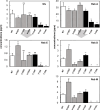Enhanced Production of Rebaudioside D and Rebaudioside M through V155T Substitution in the Glycosyltransferase UGT91D2 from Stevia rebaudiana
- PMID: 39783863
- PMCID: PMC11760145
- DOI: 10.1021/acs.jafc.4c09392
Enhanced Production of Rebaudioside D and Rebaudioside M through V155T Substitution in the Glycosyltransferase UGT91D2 from Stevia rebaudiana
Abstract
Steviol glycosides (SGs) are noncaloric natural sweeteners found in the leaves of stevia (Stevia rebaudiana). These diterpene glycosides are biosynthesized by attaching varying numbers of monosaccharides, primarily glucose, to steviol aglycone. Rebaudioside (Reb) D and Reb M are highly glucosylated SGs that are valued for their superior sweetness and organoleptic properties, yet they are present in limited quantities in stevia leaves. This study aims to improve the substrate preference and catalytic efficiency of UDP-sugar-dependent glycosyltransferase UGT91D2 from stevia, which acts as a bottleneck in the biosynthesis of Reb D and Reb M. We modeled the structure of UGT91D2 and substituted two amino acid residues, Y134 and V155, which are located near the glycosyl acceptor and donor, respectively. Expression of the UGT91D2V155T in budding yeast significantly enhanced the production of Reb D and Reb M. Furthermore, transient expression in Nicotiana benthamiana revealed that the V155T substitution improved the glucosylation activity of UGT91D2, suggesting that this substitution enhances UDP-glucose binding and reduces side reactions involving nonglucose donors. By coexpressing multiple stevia UGT genes in N. benthamiana, we successfully produced highly glucosylated SGs from steviol. Our results provide insights into the substrate specificity of UGT91D2 and contribute to the engineering of SG biosynthesis.
Keywords: UDP-glucose; UDP-sugar-dependent glycosyltransferase; stevia; steviol glycoside.
Conflict of interest statement
The authors declare the following competing financial interest(s): Y.T., M.K., J.T., and T.H. are/were employees of Suntory Global Innovation Center Ltd. The other authors declare that they have no competing interests.
Figures







Similar articles
-
Microbial production of next-generation stevia sweeteners.Microb Cell Fact. 2016 Dec 7;15(1):207. doi: 10.1186/s12934-016-0609-1. Microb Cell Fact. 2016. PMID: 27923373 Free PMC article.
-
Highly Efficient Biosynthesis of Rebaudioside M8 through Structure-Guided Engineering of Glycosyltransferase UGT94E13.J Agric Food Chem. 2024 Jul 17;72(28):15823-15831. doi: 10.1021/acs.jafc.4c03565. Epub 2024 Jul 3. J Agric Food Chem. 2024. PMID: 38959519
-
Enhanced production of steviol glycosides in mycorrhizal plants: a concerted effect of arbuscular mycorrhizal symbiosis on transcription of biosynthetic genes.Plant Physiol Biochem. 2015 Apr;89:100-6. doi: 10.1016/j.plaphy.2015.02.010. Epub 2015 Feb 19. Plant Physiol Biochem. 2015. PMID: 25734328
-
A review on rebaudioside M: The next generation steviol glycoside and noncaloric sweetener.J Food Sci. 2024 Nov;89(11):6946-6965. doi: 10.1111/1750-3841.17401. Epub 2024 Sep 25. J Food Sci. 2024. PMID: 39323262 Review.
-
Steviol glycosides: chemical diversity, metabolism, and function.J Nat Prod. 2013 Jun 28;76(6):1201-28. doi: 10.1021/np400203b. Epub 2013 May 28. J Nat Prod. 2013. PMID: 23713723 Review.
References
-
- WHO, Guideline: Sugars Intake for Adults and children. 2015, https://www.who.int/pubulication/i/item/9789241549028. - PubMed
-
- Kinghorn A. D.Stevia: The Genus Stevia; Routledge: London, 2002.
-
- Yang T.; Zhang J.; Ke D.; Yang W.; Tang M.; Jiang J.; Cheng G.; Li J.; Cheng W.; Wei Y.; Li Q.; Naismith J. H.; Zhu X. Hydrophobic recognition allows the glycosyltransferase UGT76G1 to catalyze its substrate in two orientations. Nat. Commun. 2019, 10 (1), 3214.10.1038/s41467-019-11154-4. - DOI - PMC - PubMed
MeSH terms
Substances
LinkOut - more resources
Full Text Sources

